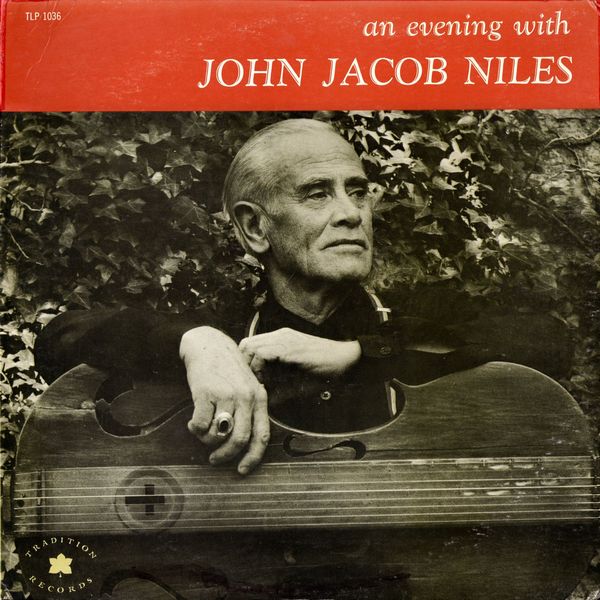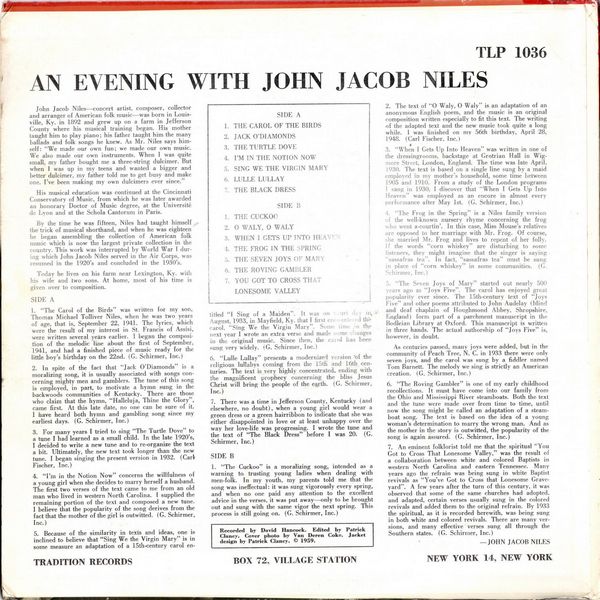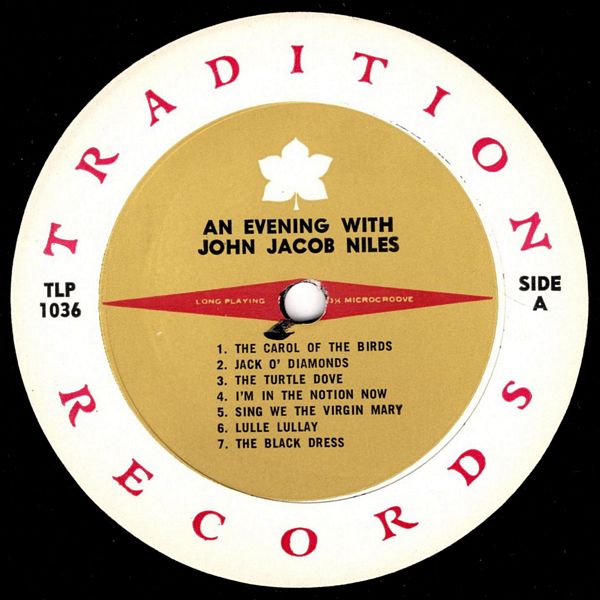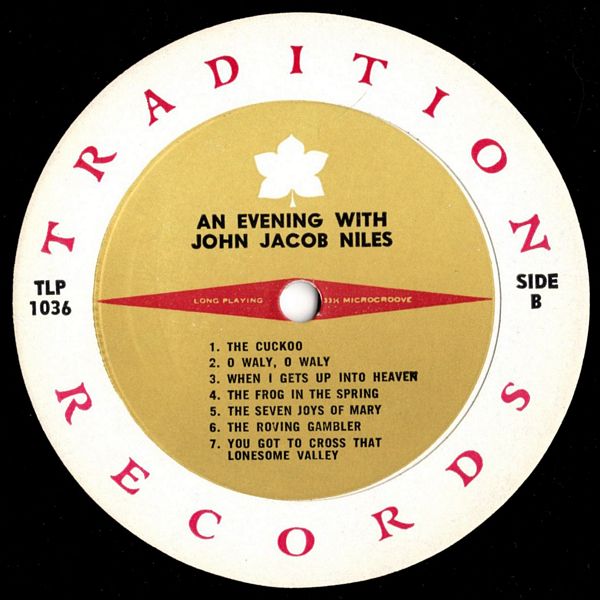

 |



|
Sleeve Notes
John Jacob Niles — concert artist, composer, collector and arranger of American folk music — was born in Louisville, Ky. in 1892 and grew up on a farm in Jefferson County where his musical training began. His mother taught him to play piano; his father taught him the many ballads and folk songs he knew. As Mr. Niles says himself: "We made our own fun; we made our own music. We also made our own instruments. When I was quite small, my father bought me a three-string dulcimer. But when I was up in my teens and wanted a bigger and better dulcimer, my father told me to get busy and make one, I've been making my own dulcimers ever since."
His musical education was continued at the Cincinnati Conservatory of Music, from which he was later awarded an honorary Doctor of Music degree, at the Universite de Lyon at the Schola Cantorum in Paris.
By the time he was fifteen, Niles had taught himself, the trick of musical shorthand, and when he was eighteen he began assembling the collection of American folk which is now the largest private collection in the country. This work was interrupted by World War I during which John Jacob Niles served in the Air Corps, was resumed in the 1920's and concluded in the 1930's.
Today he lives on his farm near Lexington, Ky. with wife and two sons. At home, most of his time is over to composition.
"The Carol of the Birds" was written for my son, Thomas Michael Tolliver Niles, when he was two years of age, that is, September 22, 1941. The lyrics, which were the result of my interest in St. Francis of Assisi, were written several years earlier. I began the composition of the melodic line about the first of September, 1941, and had a finished piece of music ready for the little boy's birthday on the 22nd. (G. Schirmer, Inc.)
In spite of the fact that "Jack O'Diamonds" is a moralizing song, it is usually associated with songs concerning mighty men and gamblers. The tune of this song is employed, in part, to motivate a hymn sung in the backwoods communities of Kentucky. There are those who claim that the hymn, "Halleluja, Thine the Glory", came first. At this late date, no one can be sure of it. I have heard both hymn and gambling song since my earliest days. (G. Schirmer, Inc.)
For many years I tried to sing "The Turtle Dove" to a tune I had learned as a small child. In the late 1920's, I decided to write a new tune and to re-organize the text a bit. Ultimately, the new text took longer than the new tune. I began singing the present version in 1932. (Carl Fischer, Inc.)
"I'm in the Notion Now" concerns the willfulness of a young girl when she decides to marry herself a husband. The first two verses of the text came to me from an old man who lived in western North Carolina. I supplied the remaining portion of the text and composed a new tune. I believe that the popularity of the song derives from the fact that the mother of the girl is outwitted. (G. Schirmer, Inc.)
Because of the similarity in texts and ideas, one is inclined to believe that "Sing We the Virgin Mary" is in some measure an adaptation of a 15th-century carol entitled "I Sing of a Maiden", .It was on court day in, August, 1933, in Mayfield, Ky. that I first encountered the carol, "Sing We the Virgin Mary". Some time jn the next year I wrote an extra verse and made some changes in the original music. Since then, the carol has heen sung very widely. (G. Schirmer, Inc.)
"Lulle Lullay" presents a modernized version of the religious lullabys coming from the 15th and 16th centuries. The text is very highly concentrated, ending with the magnificent prophecy concerning the bliss Jesus Christ will bring the people of the earth. (G. Schirmer. Inc.)
There was a time in Jefferson County, Kentucky (and elsewhere, no doubt), when a young girl would wear a green dress or a green hairribbon to indicate that she was either disappointed in love or at least unhappy over the way her love-life was progressing. I wrote the tune and the text of "The Black Dress" before I was 20. (G. Schirmer, Inc.)
"The Cuckoo" is a moralizing song, intended as a warning to. trusting young ladies when dealing with men-folk. In my youth, my parents told me that the song was ineffectual: it was sung vigorously every spring, and when no one paid any attention to the excellent advice in the verses, it was put away — only to be brought out and sung with the same vigor the next spring. This process is still going on. (G. Schirmer, Inc.)
The text of "0 Waly, O Waly" is an adaptation of an anonymous English poem, and the music is an original composition written especially to fit this text. The writing of the adapted text and the new music took quite a long while. I was finished on my 56th birthday, April 28, 1948. (Carl Fischer, Inc.)
"When I Gets Up Into Heaven" was written in one of the dressingrooms, backstage at Grotrian Hall in Wig-Street, London, England. The time was late April, 1930. The text is based on a single line sung by a maid employed in my mother's household, some time between 1905 1910. From a study of the London programs I in 1930, I discover that "When I Gets Up Into Heaven" was employed as an encore in almost every performance after May 1st. (G. Schirmer, Inc.)
"The Frog in the Spring" is a Niles family version of the well-known nursery rhyme concerning the frog who went a-courtin'. In this case. Miss Mouse's relatives are opposed to her marriage with Mr. Frog. Of course, she married Mr. Frog and lives to repent of her folly. If the words "corn whiskey" are disturbing to some listeners, they might imagine that the singer is saying "sassafras tea". In fact, "sassafras tea" must be sung In place of "corn whiskey" in communities, (G. Schirmer, Inc.)
"The Seven Joys of Mary" started out nearly 500 years ago as "Joys Five". The carol has enjoyed great popularity ever since. The 15th-century text of "Joys Five" and other poems attributed to John Audelay (blind and deaf chaplain of Houghmond Abbey, Shropshire, England) form part of a parchment manuscript in the Bodleian Library at Oxford. This manuscript is written in three hands. The actual authorship of "Joys Five" is, however, in doubt.
As centuries passed, many joys were added, but in the community of Peach Tree, N. C. in 1933 there were only seven joys, and the carol was sung by a fiddler named Tom Barnett. The melody we sing is strictly an American creation. (G. Schirmer, Inc.)
"The Roving Gambler" is one of my early childhood recollections. It must* have come into our family from the Ohio and Mississippi River steamboats. Both the text and the tune were made over from time to time, until now the song might be called an adaptation of a steamboat song. The text is based on the idea of a young woman's determination to marry the wrong man. And as the mother in the story is outwitted, the popularity of the song is again assured. (G. Schirmer, Inc.)
An eminent folklorist told me that the spiritual "You Got to Cross That Lonesome Valley," was the result of a collaboration between white and colored Baptists in western North Carolina and eastern Tennessee. Many years ago the? refrain was being sung in white Baptist revivals as "You've Got to Cross that Lonesome Graveyard". A few years after the turn of this century, it was observed that some of the same churches had adopted, and adapted, certain verses usually sung in the colored revivals and added them to the original refrain. By 1933 the spiritual, as it is recorded herewith, was being sung in both white and colored revivals. There are many versions, and many effective verses sung all through the Southern states. (G. Schirmer, Inc.)
— JOHN JACOB NILES